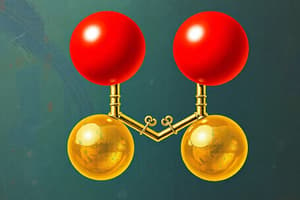Podcast
Questions and Answers
What characteristic of allenes contributes to their enantiomerism despite lacking a chiral center?
What characteristic of allenes contributes to their enantiomerism despite lacking a chiral center?
- Presence of chiral axis (correct)
- Presence of cyclic structures
- Presence of a chiral center
- Presence of double bonds between non-adjacent carbons
Which factor is crucial for the chirality of spiranes?
Which factor is crucial for the chirality of spiranes?
- Presence of symmetry in the rings
- Proper substitution on the terminal carbon (correct)
- Existence of a double bond
- Presence of a chiral center
What type of isomers are biphenyls that arise due to restricted rotation around carbon-carbon single bonds?
What type of isomers are biphenyls that arise due to restricted rotation around carbon-carbon single bonds?
- Geometric isomers
- Atropisomers (correct)
- Optical isomers
- Structural isomers
For biphenyl compounds to display enantiomerism, which condition must be met?
For biphenyl compounds to display enantiomerism, which condition must be met?
What occurs when double bonds in allene are replaced with a cycloalkane ring?
What occurs when double bonds in allene are replaced with a cycloalkane ring?
Which statement about stereochemistry in alkylidenecycloalkanes is true?
Which statement about stereochemistry in alkylidenecycloalkanes is true?
What geometric characteristic do spiranes possess?
What geometric characteristic do spiranes possess?
What term describes the phenomenon observed in biphenyls due to steric hindrance at the ortho-position?
What term describes the phenomenon observed in biphenyls due to steric hindrance at the ortho-position?
What is a plane of symmetry in reference to a molecule?
What is a plane of symmetry in reference to a molecule?
What defines a center of symmetry in a molecule?
What defines a center of symmetry in a molecule?
In the D, L system of nomenclature, what indicates a sugar belongs to the D-series?
In the D, L system of nomenclature, what indicates a sugar belongs to the D-series?
What is necessary for a molecule to have an alternate axis of symmetry?
What is necessary for a molecule to have an alternate axis of symmetry?
Which of the following describes a molecule with a 2-fold alternate axis of symmetry?
Which of the following describes a molecule with a 2-fold alternate axis of symmetry?
Which factor indicates that a molecule does NOT have a plane of symmetry?
Which factor indicates that a molecule does NOT have a plane of symmetry?
What is the primary application of the D, L system of nomenclature?
What is the primary application of the D, L system of nomenclature?
Which characteristic is NOT true about a molecule with a center of symmetry?
Which characteristic is NOT true about a molecule with a center of symmetry?
What is the term used for two atoms that can be interchanged by a mirror reflection within a molecule?
What is the term used for two atoms that can be interchanged by a mirror reflection within a molecule?
Which of the following best describes homotopic protons in n-propane?
Which of the following best describes homotopic protons in n-propane?
In the context of propionic acid, what type of ligands are Ha and Hb considered?
In the context of propionic acid, what type of ligands are Ha and Hb considered?
What defines a prochiral center in a molecule?
What defines a prochiral center in a molecule?
Which statement accurately describes a prochiral molecule?
Which statement accurately describes a prochiral molecule?
In the example of propionic acid, what happens to the optical activity upon replacing one of its hydrogen atoms?
In the example of propionic acid, what happens to the optical activity upon replacing one of its hydrogen atoms?
Which term describes protons placed in diastereomeric positions by a mirror reflection?
Which term describes protons placed in diastereomeric positions by a mirror reflection?
Which of the following statements is true regarding chiral and achiral molecules?
Which of the following statements is true regarding chiral and achiral molecules?
What designation is given to the ligand Ha in ethanol when it has higher priority over Hb?
What designation is given to the ligand Ha in ethanol when it has higher priority over Hb?
If Hb is given higher priority over Ha in ethanol, what will be the hypothetical configuration of the stereocenter?
If Hb is given higher priority over Ha in ethanol, what will be the hypothetical configuration of the stereocenter?
In the designation of enantiotopic faces, what path indicates a Re face?
In the designation of enantiotopic faces, what path indicates a Re face?
What type of ligands or atoms generate diastereomers when substituted?
What type of ligands or atoms generate diastereomers when substituted?
In the context of propene, what results from replacing one homomorphic hydrogen atom with chlorine?
In the context of propene, what results from replacing one homomorphic hydrogen atom with chlorine?
What is the priority order for the groups attached to central carbon in ethanol if Ha is preferred?
What is the priority order for the groups attached to central carbon in ethanol if Ha is preferred?
What is the E-alkene produced from propene when the opposite homomorphic hydrogen is replaced with Cl?
What is the E-alkene produced from propene when the opposite homomorphic hydrogen is replaced with Cl?
What configuration is assigned to Ha when it is replaced with deuterium 'D' in (R)-ethanol-1-D?
What configuration is assigned to Ha when it is replaced with deuterium 'D' in (R)-ethanol-1-D?
What type of products are formed when hydride is added to 4-tert-butylcyclohexanone?
What type of products are formed when hydride is added to 4-tert-butylcyclohexanone?
Why is the carbonyl carbon in 4-tert-butylcyclohexanone considered a prostereo center?
Why is the carbonyl carbon in 4-tert-butylcyclohexanone considered a prostereo center?
What is the significance of asymmetric induction in chemical reactions?
What is the significance of asymmetric induction in chemical reactions?
What role does a chiral agent play in asymmetric induction?
What role does a chiral agent play in asymmetric induction?
What distinguishes a prochiral center from a prostereo center?
What distinguishes a prochiral center from a prostereo center?
Before 1940, how were optically active compounds typically obtained?
Before 1940, how were optically active compounds typically obtained?
What happens to the reactivity of enantiomers in a biological system?
What happens to the reactivity of enantiomers in a biological system?
What term describes the stereo-chemical transformation that favors the formation of one stereoisomer over another in the presence of a chiral factor?
What term describes the stereo-chemical transformation that favors the formation of one stereoisomer over another in the presence of a chiral factor?
Flashcards are hidden until you start studying
Study Notes
Symmetry Elements
- A plane of symmetry divides a molecule into two identical halves.
- A centre of symmetry exists when for every atom in a molecule, an identical atom exists diagonally opposite at an equal distance.
- An alternating axis of symmetry (Sn) exists when a molecule is rotated by 360°/n degrees and then reflected in a plane perpendicular to the axis, resulting in an identical molecule.
Nomenclature of Optical Isomers
- D, L System of Nomenclature is used primarily for sugars and polyhydric carbonyl compounds. It's relative, meaning configurations are defined with respect to glyceraldehyde. Sugars with the OH group on the right side of the chiral atom in a Fischer projection belong to the D-series, and those with the OH on the left belong to the L-series.
Stereochemistry of Allenes
- Allenes, with cumulative double bonds, are chiral despite lacking a chiral center.
- Alkylidenecycloalkanes are formed by replacing a double bond in an allene with a cycloalkane ring. They can also exhibit enantiomerism due to a chiral axis.
- Spiranes are formed when both double bonds in an allene are replaced with rings. They can be chiral due to a chiral axis, which arises because the two rings are perpendicular.
Stereochemistry of Biphenyls
- Atropisomers are stereoisomers resulting from restricted rotation around a single bond. This phenomenon is called atropisomerism.
- Suitably substituted biphenyls exhibit enantiomerism due to a chiral axis. This arises from steric hindrance between ortho-substituents on each ring which prevents free rotation.
Topicity
- Homotopic atoms or groups are in equivalent environments.
- Enantiotopic atoms or groups are related by mirror reflection.
- Diastereotopic atoms or groups, when replaced by a different substituent, lead to diastereomeric products.
Prochirality
- A prochiral center is an achiral carbon with two identical substituents. Replacing one of these identical groups with a different one would create a chiral center.
- A prochiral molecule contains a prochiral center.
Nomenclature of Enantiotopic Ligands and Faces
- Enantiotopic ligands and faces are assigned pro-R and pro-S designations based on the CIP sequence rule.
- Two faces of a carbonyl carbon are often labeled Re and Si based on the CIP sequence rule and the direction of traversal from the highest priority group to the lowest priority group.
Diastereotopic Ligands and Faces
- Diastereotopic ligands, when replaced with a different substituent, create diastereomers.
Asymmetric Induction
- This refers to reactions favoring the formation of one enantiomer or diastereomer over the other in the presence of a chiral environment. This is also known as asymmetric synthesis.
- Chiral agents play a crucial role in asymmetric induction by influencing the transition state.
Studying That Suits You
Use AI to generate personalized quizzes and flashcards to suit your learning preferences.




